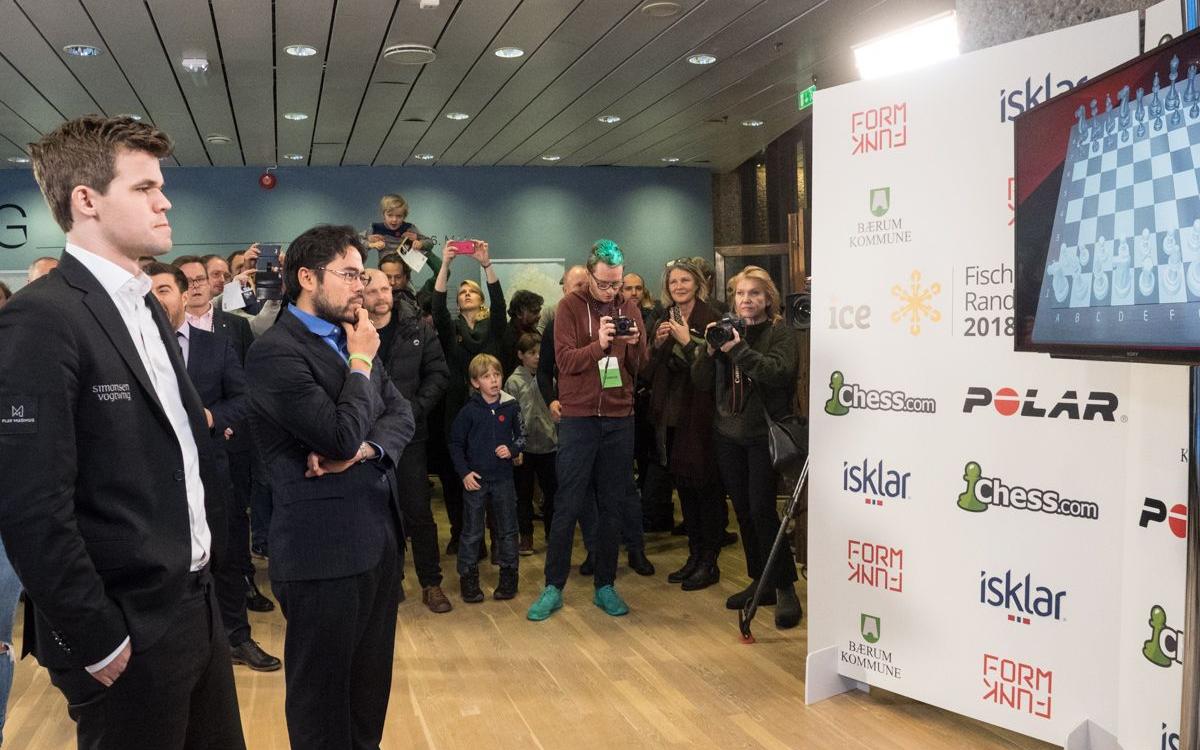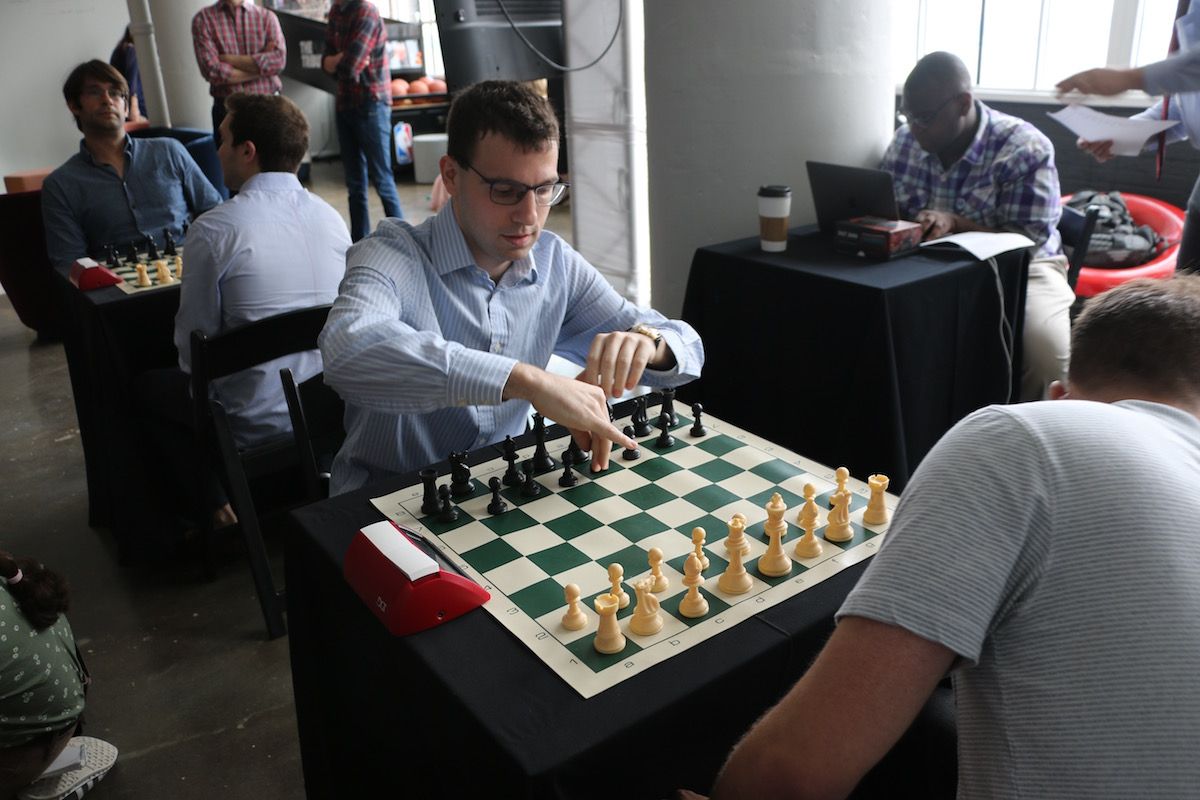
What's The Most Unbalanced Chess960 Position?
The recent Chess960 unofficial world championship match between GMs Magnus Carlsen and Hikaru Nakamura created quite a buzz. The early viewership numbers seem to prove that there's pent-up interest from chess fans to see a unique game that truly begins at move one. Of course it must be said that watching these two players solve chess puzzles or painting by number would also be enough to draw viewers.
But if Chess960 is going to catch on, can the full allotment of positions be used? The age-old starting position for chess -- RNBQKBNR -- has proven itself worthy for more than one millennium. Sure, nearly everyone prefers the white pieces, and much has been learned, but Black is hardly without chances.

GMs Magnus Carlsen and Hikaru Nakamura played the most high-profile Chess960 match ever in February. | Photo: Maria Emelianova/Chess.com.
What about other iterations of the starting positions? Recently, the Norwegian "supercomputer" Sesse analyzed all 960 variations using Stockfish 9. At a depth of 39-40 ply for each position, which took about two to three hours each, its findings were published.
Below is a sampling of various positions and a brief "human" analysis of them. Just for fun, we also gave three positions to GM Robert Hess, and let him know the three evaluations that Sesse gave, but didn't tell him which evaluation belonged to which position. We will present his explanation of each position and see if he matched them all with their correct evaluation!

Just after winning his rematch with Boris Spassky in 1992, Bobby Fischer and Susan Polgar play "Fischer Random" in Budapest. The game was a progenitor of Chess960 with slightly different rules. Here the kings were not required to start in between rooks. Photo courtesy GM Susan Polgar.
The "normal" starting position of RNBQKBNR is given as +0.22, the same evaluation as 43 other positions. I won't discuss why White is better here, since that suggests you've never watched a Chess.com video or really studied openings or famous games or really any chess whatsoever! I will say that 1. e4 is best, no question.
One could make the argument that just using these 44 positions creates enough of a stockpile to make a new sport out of them. Essentially, chess as we know it keeps it's "normal" starting advantage for White.
If that's not enough options, then there are dozens more positions within 0.01 on either side, which could expand the number of possible starting positions to near 100. That's a somewhat manageable number for someone to dabble in learning a few ideas here and there. (It should be noted that Carlsen and Nakamura each played their positions once with each color, therefore mitigating any imbalanced starting position, but presumably for Chess960 to have larger events, a double-Swiss or match situation won't always be possible.)
Here's one of the other +0.22 positions: QBRNBNKR.
What did our grandmaster think of this setup?
"White's first move is useful for a slight edge, but the fact that there are no immediate pins or deadly threats should allow Black to be alright," Hess said. "Bishop on e1 in particular requires an additional move to become active. Playing d4 will keep the bishop with limited options, while a more casual d3 can be met by ...c5, ...Ne6. And playing f3 is a positional concession."
Given all this, did he get the evaluation right? He sure did. Hess correctly guessed this was the lineup with the +0.22 advantage.

GM Robert Hess setting up for the "traditional" starting position. | Photo: Mike Klein/Chess.com.
A broad question remains: Do we want there to be zero at-home preparation as there would be with 960 positions (OK, 959; the normal setup is usually tossed out for competitions)? It's tough to prepare anything when there's that many possibilities. As the late comedian Mitch Hedberg quipped, "I can't eat spaghetti, there's too many of them."
If that's reduced to the 50-100 that exist in the same range of starting chess (0.21-0.23), then that allows sportsmen to also add some science.
Another way to think about it: Back when opening novelties were being found on move seven, did that diminish or add to the love of the game? Did that element enhance chess by rewarding players for being studious at home, and playing overall higher-quality chess? Even golfers get to play a few practice rounds before a tournament, although they do move the location of the hole every day!
What happens when professionals are well versed at a discipline, but don't know the vicissitudes of their upcoming competition? We can get a pretty good idea from the Super-G event at the PyeongChang Olympics, where no prior knowledge of the course was given. Skiers waiting their turn to race the twisty course were glued to the TV monitor at the top of the hill, watching every S-turn of the racers going in front of them.
This lack of knowledge likely contributed to crazy things happening like several disqualifications from missing gates, and also a snowboarder winning gold!

The Magnus Carlsen of snow? Czech skier/snowboarder Esther Ledecká won double gold in Pyeongchang in both disciplines. Photo: Wikimedia Commons.
If full equality from the starting position is instead the goal, then Sesse claims a flat 0.00 for 27 starting positions (there are no positions where Black is favored). Here's one of them: BBRNNQKR.
Despite it being completely "equal," you could easily argue this position is even more exciting then the normal setup. Both bishops are aiming at the king and both knights are centralized. The king could get out of Dodge by sweeping all the way across the board and castling queenside, landing on c1 (Chess960 castling rules reminder here). These radical redirections of king safety are of course a feature of many Chess960 positions, but if either side doesn't make it to the queenside, a quick attack could be launched.
This makes it somewhat surprising that a position like this is given as dead equal by the supercomputer, but perhaps the ability to rush away from danger means the advantage of moving first is mitigated.
Back to Hess, what did he think? Again, he correctly guessed this was the triple zero position. He's two-for-two.
"Black is better able to parry White's threats," he said. "In particular, the rook being on c8 allows Black to play ...c5 with protection, which does not allow White to gain a tempo."
Let's now take the most extreme case the other way -- the position where Sesse claims White enjoys the most sizable advantage. The lineup BBNNRKRQ delivers a whopping +0.57 plus for the first move. The advantaged is so marked that some Chess960 events may even jettison this arrangement as a possible option (a total of four positions are +0.50 or better for White, but none are as lopsided as this one).
You can see that this position is very similar to the lineup that produced all zeros in the evaluation. So why the large difference with this one?
It may be that the queen is now targeted by the enemy's bishop on the long diagonal. Unlike the previous example, where the rook inhabited h1/h8, the rook can castle out of there if need be, but the queen cannot.
It may also be that quicker attacks can begin with the advance of the h-pawn. The evaluation supposedly will record a higher number when it senses a quick strike in the opening. White's first-move advantage becomes more pronounced, according to computer scientist Steinar Gunderson, who is also known by the same name as his machine, "Sesse."
"Generally, the best positions for White contain early attacks that are hard to counter without putting the pieces in awkward positions," Sesse said about Sesse!
But if I'm going to be completely honest, I'm rather baffled why this position is so much better than the previous one. In fact, it only requires two pieces to leave the back row for White to castle queenside, whereas the previous position needed three (the queen is the additional piece). I would have thought that ability to castle earlier would preclude some of the lightning attacks since the king could run and hide more easily.
What it really may all come down to is the inability for humans (and low masters especially!) to really deduce a 0.50 difference in a pattern with which he has no previous experience. As I wrote about in 2010 in a cover story for "Chess Life" on game theory, numerous studies have shown that chess players aren't much better than others at solving unknown patterns.
Luckily, we have a much stronger player to deduce the reasoning. As you might guess, if you get the first two right in a matching game, Hess of course got this one correct also.
He explains: "With queen and bishop on the same diagonal, I'm tempted to start with 1. g3. If Black follows suit with 1...g6, I'm thinking 2. c4 c5 3. Nd3. Not only does White attack c5, but there seem to be possibilities of 4. b3 after 3...Ne6 with the Black queen getting trapped on a1, as in 4...Qxa1 met by 5. Nc3 followed by Bc2."
OK, finally we will close with the position that I most want to see in a Chess960 tournament (positions are usually chosen at random, so the chances aren't great): RBNQKNBR. That's right -- the starting position but with the knights and bishops swapped.
There's actually a sort of "pub" game like this: Play from the normal starting position, but knights move like bishops and bishops move like knights, and illegal move loses. After a few pints, it's hard to get through an entire game without someone erring. Maybe Bunratty should replace their ending blitz event with this one.
I asked Hess to simply pick an evaluation for this one. He didn't offer a number, but guessed that "Black isn't doing so badly." For the record, Sesse thinks my favorite position is +0.05, even more fair than chess itself. Let's go ahead and call Hess four-for-four.
Of course, the human Sesse reminds us that the exact evaluation will depend on the depth of the computer's thought, so "You shouldn't take the values as absolute gospel." It's at least good to know that the machine's programmer admits its thoughts are limited to the observable world.


